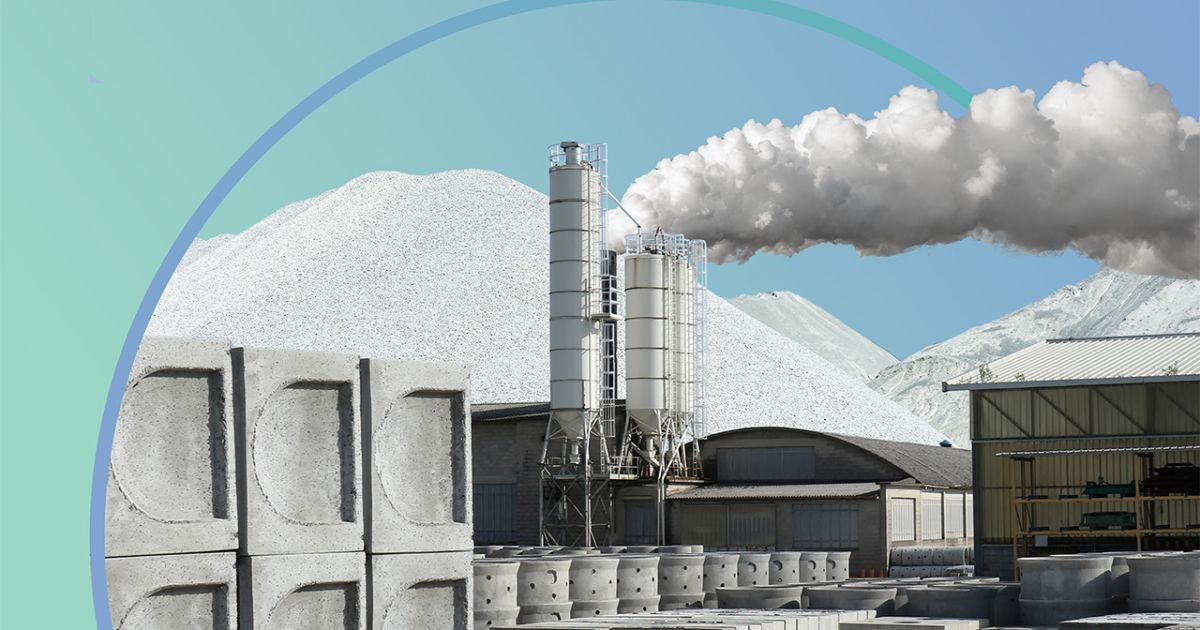Cities like Cairo; Chongqing, China; Delhi; and Kinshasa, Congo are experiencing population explosions accompanied by unprecedented demand for homes, offices, factories, and infrastructure. In the United States, the Biden Administration’s policy-driven infrastructure boom is gaining steam in the world’s largest economy.
These trends translate into ballooning global demand for steel, cement, and other raw materials used in all types of construction. This demand comes as pressure mounts for companies to reduce their greenhouse gas emissions to meet the climate targets of the Paris Agreement.
“The difficulty is that a large share of emissions is typically inherent in the production process, especially in the cement industry.”
However, heavy industry significantly contributes to global emissions. In particular, the cement industry accounts for about 8 percent of global annual carbon dioxide emissions, and cement production already doubled in the first two decades of this century.
Bad side effects
Industrial emissions are hard to abate.
“The difficulty is that a large share of emissions is typically inherent in the production process, especially in the cement industry,” says Gunther Glenk, a climate fellow at Harvard Business School’s Institute for Business in Global Society
(BiGS). He coauthored a recent working paper offering a new model to inform corporate abatement decisions.
While many companies can focus primarily on switching from fossil fuels to cleaner energy sources, industrial manufacturers face more fundamental options about production process changes and carbon capture to reduce emissions.
For example, Portland cement—the most common type of cement in general use around the world—is produced first by crushing quarried limestone and mixing it with sand or other components and water. Next, that mixture is heated at 1,400 degrees Celsius (more than 2,500 degrees Fahrenheit) and converted into calcium oxide known as clinker, a chemical reaction that releases carbon dioxide into the atmosphere. Finally, the clinker is finely ground and mixed with other materials to make cement.
New abatement cost tool
The working paper was published in August and coauthored by Glenk; Anton Kelnhofer, a consultant who was part of the research team while at Technical University of Munich; Rebecca Meier, who earned her doctorate at University of Mannheim before becoming a consultant; and Stefan Reichelstein, an accounting professor at Stanford University.
The study develops an economic framework for identifying cost-efficient combinations of abatement measures a company would need to implement to substantially reduce emissions. The authors then implement the framework in a software optimization tool and calibrate it in the context of European cement plants that must obtain emission permits under the European Emissions Trading System.
For Portland cement production, the primary abatement options include substituting clinker with supplementary cementitious materials, using biomass instead of fossil fuels for heating the kiln, and replacing limestone with recycled concrete. Emissions that can’t be eliminated during production can also be captured and stored.
A complicating factor in the analysis is that in the cement industry, as in many other industries, abatement measures exhibit interaction effects when implemented together. For example, the abatement effect of supplementary cementitious materials varies depending on whether they are combined with carbon capture equipment. Because of such interaction effects, companies cannot simply compare the abatement costs of individual measures but require an optimization algorithm that selects the cost-efficient combination of measures from all feasible combinations.
Using new industry data, the researchers examine the incentives for European cement producers to reduce emissions under different market prices for emission allowances in the European Emissions Trading System. They find that recent market prices of around 85 euros per ton of carbon dioxide incentivizes firms to reduce their annual direct emissions by about one-third relative to the status quo today. Yet, if these prices were to reach 125 euros per ton, cement producers would have incentives to reduce emissions by almost 80 percent relative to current emission levels.
Formidable targets
Research on decarbonizing cement is very timely. Several cement sector leaders have declared targets aligned with the Paris Agreement on climate change.
Forty of the world’s leading cement manufacturers—which account for 80 percent of global cement production outside of China—have committed to reaching net-zero concrete production by 2050. They include global giants that dominate the US market: Ireland’s CRH, Mexico’s Cemex, France’s Holcim, and Germany’s Heidelberg Materials. These 40 companies also are working on reducing industrywide emissions with the other major producers that are part of the China Cement Association, which represents more than half of global cement production.
Decarbonization is at the forefront of corporate strategy for cement producers with net-zero targets. In the case of Holcim, when Miljan Gutovic was designated incoming CEO in January, a press release announcing his appointment highlighted “decarbonization and advanced technologies transforming how we build.”
Teresa Landaverde Lorenzo, senior carbon manager at Heidelberg Materials headquarters in Germany, says the company is focusing strategy and mobilizing resources to meet a net-zero target by 2050. By 2023, Heidelberg achieved a reduction of more than a quarter of emissions relative to 1990. She acknowledges that the next steps will be tougher than the first ones. For example, carbon capture requires long lead times to retrofit existing facilities.
Achieving industry-wide net-zero is even more daunting. Demand for cement is forecast to proceed at a double-digit pace for decades. In recent years, China alone has consumed nearly as much concrete every two years as the United States did during the entire 20th century, according to the US Geological Survey.
Market incentives in action
Landaverde Lorenzo of Heidelberg Materials says that collaboration with academic researchers helps Heidelberg consider more and possibly better options on the road to net-zero in 2050. The new model provided by Glenk and co-authors allows Heidelberg to better strategize for interim targets in a competitive way, she says.
“We are always looking for the final score so seeking the maximum result we can get,” Landaverde Lorenzo says. She lauded the new model for helping consider choices to meet urgent needs, saying, “In cases where we need to make a specific reduction that is not zero, the model is a helpful tool.”
This article originally appeared on The BiGS Fix.
You Might Also Like:
Feedback or ideas to share? Email the Working Knowledge team at hbswk@hbs.edu.
Image created by HBSWK with assets from AdobeStock/Ruud Morijn, Luca Piccini Basile, and Zigmunds.
“Harvard Business School is the graduate business school of Harvard University, a private research university in Boston, Massachusetts. It is consistently ranked among the top business schools in the world and offers a large full-time MBA program, management-related doctoral programs, and executive education programs.”
Please visit the firm link to site





